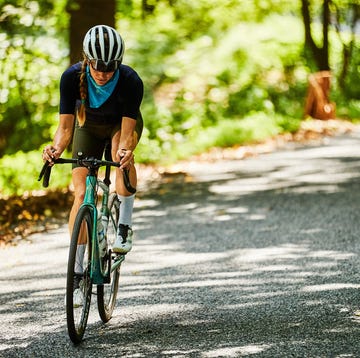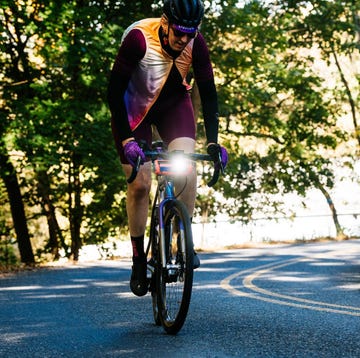The century ride is a long-distance adventure that requires a certain level of preparation, discipline, skill, and top-notch endurance. But the hard work is definitely worth the effort, as there’s nothing quite like seeing your mileage roll into the triple digits. It’s that thrill that keeps cyclists coming back to endurance challenges like the century year after year, alongside new riders eager to test their athleticism.
Get Bicycling's Guide to How to Master the Century
The thing is, century rides don’t always see 100-percent completion rates, as issues like bonking and dehydration sometimes wreck the rides of even accomplished endurance cyclists. A lot of variables play into riding for so long, so you want to prepare yourself for the 100-mile spin ahead.
Whether you’re riding your first century or want a better go at your fifteenth, check out our list of tips on ways to prepare for and ride your next century faster and smarter.
Foolproof Strategies for a Successful Century Ride
1. Take Time to Prepare
The person who did that century last August is not the same person as the one pinning on a number come March. “Over just a few weeks of inactivity, you can go from a trained to an untrained state,” says Adam Mills, a coach at Source Endurance.
It might seem like a slog, but training makes events much more enjoyable (and training itself is fun if you do it right). So even if it’s just a couple of midweek before-work slow rolls to help build up your endurance, training will go along way when you’re out there chasing 100 miles.
Plus, you only need to ride three days a week (one speed, one steady, and one long workout) to conquer our eight-week century training plan. (Don’t worry, we have longer plans, too.
2. Don’t Panic
There’s nothing like a quickly approaching deadline to spur someone into action. But freaking out before a big event, like a century ride, and stocking up on long workouts close to the race date—rather than tapering—will leave you tired from the starting line.
Instead of cramming in long rides right up to event day, adopt a sensible approach and gradually increase training volume. “If you’re not fit a week out, you won’t be getting any faster in those final seven days. It’s best to do a real taper in the last week,” Mills says.
If you really want to crush your race, follow a training plan that tells you when to go hard, t00. “I suggest that riders consult an experienced coach to help them approach the event,” Mills adds.
3. Add Interval Training
Most of us have jobs, kids, and/or a time-consuming internet habit, so high-volume training isn’t always an option. But if you don’t have much training time, most coaches will suggest your workouts go beyond a steady-pace ride.
Interval training gives you the best return on your limited training time, as research shows that it can improve your power output, as well as kick up your endurance in prep for your century ride finish.
The beauty of HIIT training, besides helping you get fitter in a shorter amount of time, is that there are so many ways to do intervals, from quick 30-second sprints to minutes-long pushes. “Interval training can sometimes be monotonous—but lean into it! There’s something satisfying about seeing yourself click off reps and know you’re getting fitter. Plus, hard intervals make the recovery rides that much sweeter,” says news editor Theo Kahler.
4. Get a Bike Fit
Riders are quick to spend their hard-earned money on entry fees and carbon wheels, but might want to first consider the efficiency they could gain by having a proper bike fit. Not only will a comfortable bike give you better power transfer on the day of the race, but it will also have you riding more in the weeks beforehand, with less pain and risk of injury.
As you’ll discover after your first spin on a bike better fit for you, you don’t have to let neck aches or back pain derail your 20-mile ride. Kahler agrees and believes riding an ill fitting bike is a sure fire way to start to resent cycling. “Once you go the extra step and visit a professional bike fitter, you’ll notice a lot of aches and injury flareups slowly start to dissipate,” he says. Plus, he adds, you’ll be better able to crank out more watts if your bike is customized to your measurements.
5. Review the Ride Route and Profile
Plenty of century rides feature a sting in the tail: This sting hurts even more if you don’t know it’s coming. Knowing where the climbs and headwinds are allows you to position yourself well in the group, eat in advance of hard efforts, and save some matches to burn on those last steep pitches.
Aim to make your century route fun if you can, as Bicycling deputy editor, Tara Seplavy did with her recent century. “Pick a destination that makes the reward even sweeter. I chose a combination bike/ramen/coffee/ice cream shop that I have wanted to check out for a couple months,” she says.
6. Fuel Right
Louise Burke, former head of the Australian Institute of Sport coined the phrase “garbo-loading” to describe athletes overeating high-fat foods under the pretense of “carb-loading” for an event.
Instead of binging on ice cream and Alfredo sauce-covered pasta the night before a race, Sean Burke, exercise physiologist, suggests sticking to easily digestible, low-bulk carbohydrates. This includes choices like crackers or white rice.
Experts suggest about 10 to 12 grams of carbohydrate per kilogram of body mass (or 4.5 to 5.5 grams per pound) in the 24 to 48 hours before an event.
7. Learn From What You Did in Training
The preride gear expos that accompany some century events are like Santa’s workshop—it’s hard not to pick up some new toys. But Burke says one of the most common mistakes is trying a new product, often a new energy bar or gel, during a big event.
“People spend months training, and then ruin it all because they saved five bucks by using free drink mix,” he says. That’s because your body might not be accustomed to (or might even be intolerant to) new training fuel, shoes that give you unanticipated blisters, or saddles that rub in all the wrong ways.
Burke suggests you stick to the acronym TEST IT (Try Everything Several Times in Training) before you use it in an event.
8. Start Conservatively
Contrary to what Katy Perry has told us, you don’t want to be a firework that burns brightly, then explodes. A 2012 article in the Journal of Sports Medicine revealed what many of us today hold to be gospel: “[Endurance] performance times may be improved if athletes distribute their pace more evenly.” This is hardly a shocking concept, but sometimes it helps to hear it.
“Pace yourself. One hundred miles is long for almost any cyclist, but it’s manageable for most riders. A big mistake riders make is going out too hard in the first third to half of the ride and bonking or cramping,” says Seplavy.
Ensure you hold back by starting at a speed that doesn’t force you to breathe through your mouth. You can always pick it up later when you feel you have enough gas left in the tank to make it across the finish line with strength.
“If your first century is part of a larger event, find a group that’s going at a pace that suits your own. It’s better to roll with a group that’s a little slower than one that’s unsustainably fast,” says Bicycling test editor Dan Chabanov.
9. Draft When You Can
The one caveat to the previous point is this: Go hard to get in a pack, then go easy. “As long as the effort to get into the group isn’t too much to completely exhaust the rider, the energy savings of drafting within a group for several hours are massive,” says Chris Yu, former leader of innovation at Specialized and current vice president of future programs at Rivian.
According to Yu, a rider will see about a 40-percent reduction in power while riding within in a group, less while climbing. “Over a five-hour ride, that translates to between 1,000 to 2,000 kJ of energy saved versus riding alone—an entire meal’s worth” he adds.
10. Eat Early and Often
The Journal of the International Society of Sports Nutrition says that there is a significant benefit to eating carbohydrate during exercise lasting more than 60 to 90 minutes. But many of us forget to take advantage of the benefits of that added energy and glucose. You’re so excited and nervous about the century ride that you forget to eat until the pack thins out 20 miles into the ride.
Here’s your reminder: Grab about 20 grams of carbohydrate every 30 minutes—set an alarm if you need it. This allows the food to digest and hit the blood stream when you need it.
Chabanov suggests to start planning your food the night prior. “Proper fueling begins the night before—especially if you have an early start the next morning. Have a big dinner. Eat a big breakfast. Bring lots of ride food with you,” he says.
Don’t forget about hydration, as well. “Learn in your training how much water your body needs, what hydration mix works best for you, and how many calories you need to stay riding strong. And figure out ahead of time exactly where you can stop for food and water,” suggests Bicycling photo editor John Hamilton.
Phil Tinstman, a former winner of RAAM and the tandem and solo categories at El Tour de Tucson, says, “I always make it a point to eat something every hour, whether its a homemade PB and honey or a bar that I am familiar with and know that my stomach appreciates. There is nothing worse than getting four hours in and getting that starving, bonking feeling.” Just remember his keywords: Food your familiar with during the century ride.
Jennifer Acker reports on a wide range of health and wellness topics for Runner’s World and Bicycling. She’s passionate about delivering journalism that enriches the lives of readers. Jennifer is a lifelong runner—with several half marathons, and a few marathons under her belt, certified yoga instructor, and having grown up in the Pocono Mountains, always has a mountain bike and pair of skis ready for the perfect fall or winter day.















